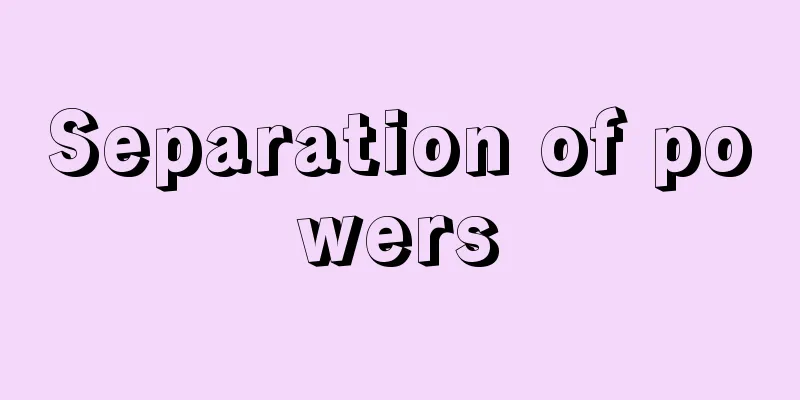Separation of powers

|
A system of government in which state power is distributed among multiple governing bodies, and politics is conducted through checks and balances between the various powers. The purpose is to prevent state power from concentrating in a specific governing body or individual and becoming an autocracy. Since Montesquieu advocated the separation of powers among the legislative, judicial, and executive branches in The Spirit of the Laws (1748), the idea and system of separation of powers has been established in most modern countries today, to the extent that the term "separation of the three powers" immediately comes to mind when talking about separation of powers. In other words, the idea of separation of powers, along with the idea of protecting human rights, is considered to be the most fundamental ideological principle in modern democratic politics, as seen in the wording of the French Declaration of the Rights of Man, which states, "A society in which the protection of rights is not ensured and the separation of powers is not established cannot be said to have a constitution" (Article 16). [Hiroshi Tanaka] The origins of the idea of separation of powersThe idea of separation of powers was first seen in ancient Greece, when Aristotle envisioned the best state by combining three types of political systems: monarchy, aristocracy, and democracy. However, the origin of the idea of separation of powers in the modern sense can be found in the political practices of medieval Europe, especially in England from the end of the 13th century, when estates were established to counter the growing power of absolute monarchs. In England, the idea of cooperative governance based on checks and balances between royal and parliamentary power was gradually formed by gradually establishing a political management method in which the king must govern while respecting the laws enacted by Parliament. However, in the 17th century, the kings of the Stuart dynasty followed the example of the French kings and aimed to expand and strengthen royal power, and tried to destroy the balance between royal and parliamentary power, which led to the first civil revolution in history (the Puritan Revolution). From then on in England, the medieval view of politics, which held that it was sufficient to maintain a balance between royal and parliamentary power, was replaced by a theory of governing structures based on the principle of popular sovereignty, and the theory of separation of powers came to be discussed as part of this new theory of democratic political institutions. [Hiroshi Tanaka] Harrington's separation of powers theoryThe theory of democratic separation of powers was first formulated by the English thinker Harrington. In his major work Oceana (1656), he proposed the establishment of two representative houses elected by the entire nation from 150 districts: The Senate, which would only submit bills, and The People, which would only vote on the bills that were submitted. His strict separation of the powers of the two houses was based on his criticism of the British Parliament at the time, which elected representatives only from the propertied classes, and they submitted and voted on bills in Parliament, so that Parliament ultimately realized special interests. Even in modern countries with universal suffrage, if the majority party continues to monopolize the government for many years, the situation that Harrington feared could occur, so Harrington's proposal is still worth considering today. Harrington also argued that representatives should be selected by lottery (ballot), and that representatives and officials should be rotated every two years. This system is an imitation of the Greek approach and cannot be immediately adopted in modern nations with their huge and complex structures; however, it can be considered a kind of separation of powers theory in that it aims to eliminate money politics and collusion between economic interests and government officials. [Hiroshi Tanaka] Locke and Montesquieu on the separation of powersThere is much to be said for Harrington's proposal, but since parliament had been developed for many years in England, democratic politics in England after the Glorious Revolution (1688) progressed in the form of a separation of powers between the king and parliament. In his book Two Treatises of Government (1690), Locke argues for the separation of powers between Parliament, which has legislative power, and the king, which has administrative and alliance (diplomatic) powers. However, in this case, what differs from the separation of powers theory before the Civil Revolution is that Locke argues that if a conflict arises between Parliament and the king, the power of Parliament will take precedence over that of the king. Locke's idea later came to fruition in England as a parliamentary cabinet system, in which the government can only exist with the confidence of Parliament. Incidentally, it was the Frenchman Montesquieu who clarified the separation of powers between the legislative, judicial, and executive branches. Since then, the separation of powers has come to be identified with the separation of powers between central governing bodies, and today, the separation of powers is applied in various political systems. [Hiroshi Tanaka] Examples of separation of powers in various countriesAs mentioned above, the separation of powers was first applied in British politics. In this country, if Parliament believes that the government's policies are not in the interest of the people, it can pass a motion of no confidence in the government, and on the other hand, the government can counter this by exercising its power to dissolve Parliament, so it can be said that a relationship of checks and balances exists between Parliament and the government. However, in a parliamentary cabinet system, the majority party in Parliament is in charge of the government, so the relationship between Parliament and the government can be said to be more of a fusion than a separation. The American political system is the one that most strictly adheres to the separation of powers. The British have a strong trust in Parliament, because Parliament played a central role in overthrowing an absolute monarch. However, Americans feared that Parliament would become tyrannical, as they had been subjected to various forms of oppression not only by the king but also by Parliament in the years leading up to the Revolutionary War. Therefore, in addition to the separation of powers between the legislative and executive branches, they adopted a system in which the judiciary is given the power to review unconstitutional legislation, thereby checking the actions of the legislative and executive branches. In the United States, the president is elected by a different method than the members of the Diet, and the secretaries (ministers) of his cabinet are chosen from among non-members. The president and the cabinet have no right to submit bills or to dissolve the government. They can only recommend the creation of desirable legislation and policies through "messages." If a law or policy that the president does not want is about to be decided, the president can exercise his "veto," but if Parliament re-votes by more than two-thirds, he cannot prevent the bill from being passed. It is believed that this strict idea of separation of powers was largely inspired by Harrington's ideas; in fact, it is said that Jefferson, the father of American independence, was an avid reader of Oceana. In America, the separation of powers is strongly reflected not only within the central governing body, but also in the relationship between the central government and local governments. Apart from the powers (enumerated powers) that the President holds that are deemed necessary from the perspective of national unity, the politics of each state are left to the individual states, and states enjoy extremely strong independence. Each state has a parliament, a government, and even a supreme court, and each state has its own constitution, civil code, criminal code, etc. In this respect, it is clear that the nature of local autonomy is quite different from that of Japan. In prewar Japan, the Imperial Diet, the Cabinet, and the courts were established, each exercising their own powers, but the Emperor held ultimate sovereignty, so the separation of powers was ultimately merely a formality. In other words, the Imperial Diet was considered to be a supporter of the Emperor's legislative work, and the Meiji Constitution contained no explicit provisions for a parliamentary cabinet system. As a result, although a party cabinet system emerged for a time from the late Taisho period to the early Showa period, most of Japan's politics were under the control of clan factions, bureaucrats, and military cabinets. Although the judiciary maintained a relatively high degree of independence, the Constitution stipulated that trials be conducted "in the name of the Emperor." In this way, without the principle of popular sovereignty, the separation of powers cannot achieve the purpose of realizing democratic politics. However, the postwar Japanese Constitution established a separation of powers to guarantee democratic government, stipulating that "The Diet shall be the highest organ of state power and the sole law-making organ of the State" (Article 41), "Executive power shall be vested in the Cabinet" (Article 65), and "All judicial power shall be vested in the Supreme Court and in inferior courts" (Article 76). In particular, with regard to the judiciary, the courts were given American-style power to review legislation for constitutional violations, and with regard to local politics, local autonomy was clearly stated in Chapter 8 of the Constitution, establishing a direction to move away from the centralized government of the past and towards decentralized democratic politics. [Hiroshi Tanaka] Criticism of the separation of powersSocialism and fascism are critics of the separation of powers. According to socialism, the political system in capitalist countries was ultimately created to protect the interests of the propertied bourgeoisie. Therefore, when the socialist revolution was successful, the existing political system was completely abolished and a completely new type of power institution was created, centered on the workers and peasants who make up the majority of the population. This model is the political system of the former Soviet Union and China. There is no free candidacy system as seen in capitalist countries, and candidates are recommended by party organizations, unions, cultural organizations, etc. in each region. There is also no political management system in which multiple parties take turns ruling, and the Communist Party is the sole party in charge. For this reason, capitalist countries accuse them of being dictatorships, but socialist countries call this political system "democratic centralism," as they believe that this is the organization that truly represents the interests of the people. However, as can be seen from the fact that a bureaucratic dictatorship similar to what was historically known as the "Stalin regime" emerged in the former Soviet Union, and that conflicts over self-management were observed between the government and the people in the socialist countries of Eastern Europe, there is no doubt that the relationship between power and freedom, and issues surrounding liberalization, in existing socialist countries such as China, are important issues that will need to be improved and resolved in the future. Furthermore, the communist parties of advanced capitalist countries have now revised their position of completely rejecting the existing political system, and are aiming for a transition to socialism centered on parliaments, which are the national representative organs, and have begun to acknowledge the existence of multi-party systems. On the other hand, fascist countries such as Italy, Germany and Japan that emerged in the 1920s and 1930s opposed the Western powers and created political systems with the aim of eliminating the threat of Soviet socialism, and to this end severely suppressed the freedom and human rights of their citizens and denied all democratic political institutions such as parliaments, political parties and unions. However, with their defeat in World War II, the fascist countries collapsed, and these countries were able to make a fresh start as democratic nations. [Hiroshi Tanaka] Issues in the theory of separation of powersUnlike the times of Hobbes and Locke, modern states have become extremely complex and specialized in their roles, and as a result, their power is becoming ever stronger. For this reason, in order to realize democratic politics in each country, it is no longer sufficient to simply guarantee the separation of powers in the central governing body and the separation of powers between the central and local governments in the constitution. What is most important in realizing the spirit of separation of powers is to widely cultivate a democratic spirit among the people, and on that basis to assemble democratic institutions and rules for political administration throughout politics. It is also necessary to have the wisdom and courage to constantly and flexibly reorganize institutions in response to changing circumstances. [Hiroshi Tanaka] "The State and the Individual" by Hiroshi Tanaka (1990, Iwanami Shoten) Source: Shogakukan Encyclopedia Nipponica About Encyclopedia Nipponica Information | Legend |
|
国家権力を複数の統治機関に配分し、権力相互間における抑制・均衡によって政治を行う統治方式。国家権力が特定の統治機関や個人に集中して専制化することを防止するのを目的とする。モンテスキューが『法の精神』(1748)のなかで立法・司法・行政間の権力分立を説いて以来、権力分立といえばただちに三権分立という語が思い浮かぶほどに、権力分立の思想と制度は今日ほとんどの現代国家において定着している。つまり権力分立の思想は、フランス『人権宣言』の「権利の保障が確保されず、権力の分立が確立されていないすべての社会は憲法をもつものとはいえない」(第16条)という文言(もんごん)にもみられるように、人権保障の思想とともに、近代民主政治におけるもっとも基本的な思想原理と考えられているのである。 [田中 浩] 権力分立思想の起源権力分立の思想は、遠くは古代ギリシアにおいて、王政・貴族政・民主政という3種類の政治制度を混合して最善の国家を構想したアリストテレスの考えのなかに早くもその萌芽(ほうが)形態がみられる。しかし、近代的な意味での権力分立思想の起源は、絶対君主の権力増大に対抗して身分制議会が設立された中世ヨーロッパ、とくに13世紀末以降のイギリスにおける政治的実践のなかに求めることができよう。すなわち、イギリスでは、国王は議会の制定した法律を尊重しつつ統治しなければならない、という政治運営の方式を徐々に確立していくことによって、王権と議会権力との間の抑制・均衡に基づく協働統治という観念がしだいに形成されていった。しかし、17世紀に入ってスチュアート朝の諸王が、フランス国王に倣って王権の拡大強化を目ざし、王権と議会権力の均衡を破壊しようとしたときに史上初の市民革命(ピューリタン革命)が勃発(ぼっぱつ)した。以後、イギリスでは、王権と議会権力との均衡統治を保持すれば足りるとする中世的政治観にかわって、国民主権の原理に基づく統治機構論が登場し、権力分立論もこの新しい民主的政治制度論の一環として論議されることになったのである。 [田中 浩] ハリントンの権力分立論民主的な権力分立論はイギリスの思想家ハリントンによって最初に定式化された。彼は主著『オシアナ』(1656)のなかで、150の地区から全国民的規模によって選出される二つの代議院の設立を提案している。もっぱら法案を提出するだけの院(The Senate)と、もっぱら提出された法案を議決するだけの院(The People)がそれである。彼が二つの院の権限を厳格に分離したのは、当時のイギリス議会が有産者層からだけ代表者を選出し、しかも彼らは議会で法案を提出しかつ議決するため、結局のところ議会は特殊利益を実現している、ということに対する批判に基づくものであった、といえよう。普通選挙制が実施されている現代国家においても、もしも長年にわたって多数党が政権を独占し続けると、ハリントンが恐れたような事態が発生しかねないことを考えれば、ハリントンの提案は今日でも一考に値するものといえよう。このほかハリントンは、代議員はくじ引き(バロット)で選ばれ、代議員と官吏は2年交替(ローテーション)にすべきであると主張している。この方式は、ギリシア時代のやり方を模倣したものであり、現代のような巨大かつ複雑な仕組みをもつ国家においてはただちに採用するわけにはいかないが、金権政治や経済的利害と官吏との癒着を排除することを目ざしたものであるという点からみると、一種の権力分立論といえよう。 [田中 浩] ロックとモンテスキューの権力分立論ハリントンの提案には聞くべきものが多いが、イギリスでは長年にわたって議会が発達してきたので、結局、名誉革命(1688)後のイギリスの民主政治は、国王と議会の権力分立という形で進行した。ロックはその著『政治二論』(1690)において、立法権をもつ議会と行政・同盟(外交)権をもつ国王との権力分立論を主張している。しかしこの場合、市民革命前の権力分立論と異なるのは、ロックが、議会と国王との間に矛盾が生じれば、議会の権力が国王の権力に優位するとした点である。ロックのこの考え方はその後イギリスにおいて、政府は議会の信任によってのみ存続するという議院内閣制へと結実していくことになる。ところで、立法・司法・行政の間の三権分立を明確化したのはフランスのモンテスキューであった。以後、権力分立は中央統治機関の間の三権分立と同一視されるまでになったが、現在では、さまざまな政治の仕組みのなかで権力分立制が応用されている。 [田中 浩] 各国における権力分立の実例前述したように権力分立はまずイギリスの政治のなかで適用された。ここでは、政府の行う政治が国民の利益に合致しないと思えば、議会は政府に不信任決議を突きつけることができ、他方、政府も議会を解散する権限を行使してこれに対抗できるから、議会と政府の間に抑制・均衡の関係が成立しているといえよう。しかし、議院内閣制においては、議会内多数党が政権を担当するので、議会と政府との関係は、分立というよりもむしろ融合関係にあるともいえる。 三権分立をもっとも厳格に守っているのはアメリカの政治制度である。イギリス人は、議会が中心となって絶対君主を打倒したので、議会に対する信頼感が強い。しかしアメリカ人は、独立戦争までの数年間、本国の国王だけでなく議会からもさまざまな抑圧を受けたとして、議会の専制化をも恐れたのである。そこで、立法部と行政部との間の権力分立はもとより、司法部に違憲立法審査権を与えることによって立法部と行政部の行動をチェックさせる方式を採用したのである。アメリカでは、大統領は国会議員とは別の方式で選挙され、また彼の内閣の長官(大臣)たちは議員以外から選ばれる。大統領や内閣には法案提出権もなければ解散権もない。ただ「教書」を通じて望ましい立法や政策の立案を勧告するにとどまる。もしも、大統領の意に添わない法律や政策が決定されそうなときには大統領は「拒否権」を発動できるが、議会が3分の2以上の多数で再議決すれば、法律案の可決を阻止することはできない。こうした厳格な権力分立の考え方はハリントンの思想に学ぶことが多かったと思われ、事実、アメリカ独立の父ジェファソンは『オシアナ』を熱読していたといわれている。 ところで、アメリカにおいては、単に中央統治機関内部の間だけでなく、中央と地方との関係についても権力分立的性格が色濃く反映している。大統領は全国家的統一という観点から必要と思われる権限(列挙権限)をもつほかは、各州の政治は各州に任せ、州の独立性がきわめて強い。各州には議会、政府のほか最高裁判所まであり、州ごとに憲法、民法、刑法などもある。この点、日本の地方自治とはかなり性格を異にすることがわかる。 戦前の日本では、帝国議会、内閣、裁判所が設けられ、それぞれその権力を行使していたが、統治権は天皇が総攬(そうらん)するとなっていたので、三権分立も結局は形式的なものにすぎなかった。すなわち、帝国議会は天皇の立法の仕事を協賛するものとされ、明治憲法には議院内閣制に関する明文規定はなく、このため、大正後期から昭和初期にかけて一時期、政党内閣制が出現したものの、日本の政治の大半は、藩閥、官僚、軍閥内閣の支配下にあった。司法部は比較的独立性を保っていたとはいえ、憲法上は「天皇ノ名ニ於(おい)テ」裁判を行うものとされていた。このように国民主権の原理がないところでは、権力分立も民主政治を実現する目的を達しえないのである。しかし戦後の日本国憲法においては、「国会は、国権の最高機関であつて、国の唯一の立法機関」(41条)、「行政権は、内閣に属する」(65条)、「すべて司法権は、最高裁判所及び……下級裁判所に属する」(76条)と規定され、民主政治を保障する三権分立制が確立された。とくに司法部については、アメリカ型の違憲立法審査権が裁判所に与えられ、また地方政治についても、憲法の第8章において地方自治を明記し、かつての中央集権的政治から地方分権的な民主政治を進める方向が確立された。 [田中 浩] 権力分立制に対する批判権力分立制に対する批判としては社会主義とファシズムがある。社会主義によれば、資本主義国家における政治制度は、結局は有産者ブルジョアジーの利益擁護のためにつくられたものとみる。したがって、社会主義革命が成功したときに、既存の政治制度をいっさい廃棄して、国民の大半を占める労働者・農民を中心とするまったく新しいタイプの権力機関をつくることとなった。このモデルが旧ソビエト連邦や中国の政治制度である。ここでは、資本主義国家にみられるような自由な立候補制はなく、候補者は各地区の党機関・組合・文化団体などから推薦され、また複数以上の政党による政権交替という政治運営の方式もなく、共産党一党が指導する。このため、資本主義国家の側からは独裁制であるとの非難がなされているが、社会主義国家の側では、このような政治制度こそ真に国民の利益を代表できる組織であるとして、それを「民主集中制」という名でよんでいる。 しかし、旧ソ連でも歴史上「スターリン体制」といわれたような官僚主義的独裁制が出現したこともあり、また東欧社会主義諸国においては自主管理をめぐって政府と国民との間に対立がみられたこともあったことからもわかるように、中国など現存社会主義諸国における権力と自由の関係、自由化をめぐる問題が、今後とも改善・解決を迫られる重要問題であることは間違いない。また、先進資本主義諸国の共産党は、現在では既存の政治制度をまったく否定するという立場を修正し、国民代表機関である議会を中心に社会主義への転換を目ざし、複数政党制の存在も認めるようになってきている。 他方、1920、30年代に出現したイタリア、ドイツ、日本などのファシズム国家は、西欧列強と対抗し、旧ソ連社会主義からの脅威を排除する目的で権力集中型の政治体制をつくり、そのために国民の自由や人権を厳しく抑圧し、議会、政党、組合などの民主的な政治制度をいっさい否定した。しかし、第二次世界大戦の敗北によってファシズム国家は崩壊し、これらの国々も新しく民主主義国家として再出発した。 [田中 浩] 権力分立論の課題現代国家は、ホッブズやロックの時代と異なり、国家の役割はきわめて複雑化・専門化し、したがって国家の権力もますます強大化しつつある。このため、各国において民主政治を実現するためには、単に中央統治機関における三権分立や中央と地方との間の権力分立を憲法上保障するだけではもはや十分なものとはいえない。権力分立の精神を実現するうえでもっとも重要だと思われることは、国民の間に民主的な精神が広範に育成され、それを基礎に政治のすみずみにわたって民主的な制度や政治運営のルールを組み立てることであり、また情況の変化に応じて絶えず柔軟に制度を組み替える知恵と勇気が必要とされるということである。 [田中 浩] 『田中浩著『国家と個人』(1990・岩波書店)』 出典 小学館 日本大百科全書(ニッポニカ)日本大百科全書(ニッポニカ)について 情報 | 凡例 |
<<: Abuse of rights - Kenriranyou
Recommend
Pasiphaea sivado (English spelling) Pasiphaea sivado
… [Takeda Masatomo]. … *Some of the terminology t...
Vortex - Uzuwa
〘Noun〙① A round shape resembling a spiral. ② An ab...
Command norms - command norms
It simply means a norm that stipulates that a cert...
Kincha - Kincha
...At first it had a strong religious character, ...
Liberation Day - Kaihokinenbi
In that sense, the 8/15 liberation can be said to...
Seki City Ode - Kanshi no Fu
…This phenomenon is recognized in Chinese academi...
Iinogawa - Iinogawa
A district in the center of Ishinomaki City, nort...
Money, Credit and Commerce
...Households and businesses hold a portion of th...
Silicon monoxide (silicon monoxide) - Issankakeiso (English spelling) silicon monoxide
Chemical formula: SiO. Also known as monox. An opa...
Leather bellows - Kawafuigo
…The former developed mainly into the European be...
Hellenistic art - Hellenistic art
The diversity of concepts surrounding the term &qu...
Phyllodoce alpina (English spelling)
… [Kei Yamazaki]. … *Some of the terminology that...
Babak (English spelling)
…a rebellion (816-837) led by Bābak (?-838), a le...
Shijo family
Descendants of the Uona lineage of the Northern H...
Japanese Art
From prehistoric times to the historical period, ...





![Fukumitsu [town] - Fukumitsu](/upload/images/67ccb0d9028a1.webp)



